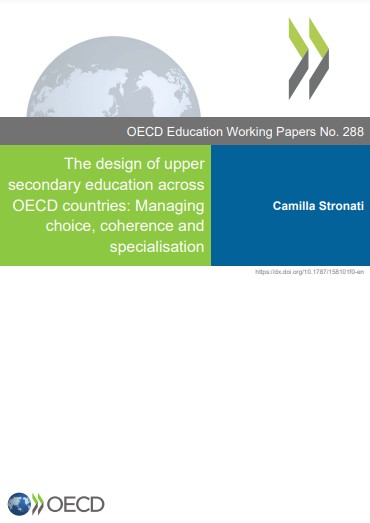
목차
Title page
Contents
Acknowledgments 4
Abstract 5
1. Introduction 8
Aims of this working paper 8
Methodology 10
2. Understanding and defining programme design in upper secondary education 12
Identifying upper secondary education across countries 12
Definitions and terms used to describe upper secondary education systems 15
Distinguishing features of upper secondary programmes from a comparative perspective 15
3. Programme diversity across upper secondary education systems 19
What is programme diversity? 19
Separate provision of general and vocational programmes 19
Programmes that provide no or partial completion of ISCED 3 25
Programme destination 30
The number of educational programmes in upper secondary education 35
The age at which selection into programmes is made 39
Policy framework for managing diversity in upper secondary programmes 42
4. Options and specialisations within upper secondary programmes 45
The structure of upper secondary programmes across OECD countries 45
Compulsory content in upper secondary programmes 48
The role of student choice in upper secondary subjects 59
The role of specialisation in upper secondary education 62
Policy framework for options and specialisation within upper secondary programmes 66
5. Synthesis and conclusions 69
Overview of policies that shape upper secondary design 69
How do different upper secondary systems affect students' outcomes? 70
6. Further work 74
References 76
Annex A. Upper secondary programmes and subjects 82
Table 3.1. Classification codes for education programmes at ISCED level 3 26
Table 3.2. Dimensions of horizontal stratification 37
Table 3.3. Types of diversity in upper secondary programmes and implications for policy making 44
Table 4.1. Common core in general and vocational programmes in upper secondary education 55
Table 4.2. Share of compulsory and elective courses in general upper secondary education 61
Table 4.3. Aspects of curriculum structure and implications for policy making 68
Table 5.1. Key design features of upper secondary systems internationally 69
Figure 2.1. Upper secondary education systems across OECD countries 14
Figure 3.1. Share of students aged 15-19 enrolled in upper secondary, by programme orientation 22
Figure 3.2. Students attending vocational education, socio-economic status 24
Figure 3.3. Distribution of students enrolled in upper secondary vocational programmes (2018) 30
Figure 3.4. Education programmes available to students in upper secondary education and age at first selection 40
Figure 5.1. Employment rates of 25-34 year-olds, by educational attainment and programme orientation (2021) 73
Boxes
Box 1.1. Above and Beyond: Transitions in Upper Secondary Education 9
Box 1.2. OECD, Indicators of Education Systems programme 11
Box 2.1. Principal characteristics of upper secondary education, ISCED 2011 12
Box 3.1. Programme orientation in ISCED 19
Box 3.2. Level completion and access categories for ISCED 3 26
Box 3.3. Entry-level programmes that provide only partial completion of ISCED 3 28
Box 3.4. Upper secondary general programmes and eligibility criteria to enter tertiary education 33
Box 3.5. Challenges of international classifications on orientation 35
Box 3.6. Flexibility in the Netherlands 42
Box 3.7. Policy considerations for managing programme diversity 43
Box 4.1. Upper secondary education in the United Kingdom: An outlier 47
Box 4.2. Identifying and implementing core foundations 48
Box 4.3. Cross-curricular competencies in upper secondary education 49
Box 4.4. Setting flexible minimum standards 52
Box 4.5. Breadth versus depth in upper secondary education 54
Box 4.6. Information gaps 59
Box 4.7. Specialisations and options within vocational upper secondary programmes 64
Box 4.8. Specialisation in upper secondary education in Sweden 65
Box 4.9. Policy considerations for managing options and specialisation within upper secondary programmes 67
Annex Tables
Table A.1. Upper secondary programmes 82
Table A.2. Compulsory subjects in upper secondary education 96
해시태그
관련자료
AI 100자 요약·번역서비스
인공지능이 자동으로 요약·번역한 내용입니다.
The design of upper secondary education across OECD countries : managing choice, coherence and specialisation
(OECD 회원국의 고등교육 설계)



